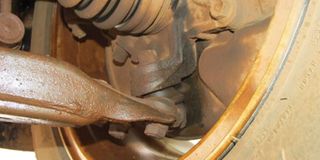Avoid ball joint failure

How a ball joint looks like. PHOTO BY MUSTAFA ZIRABA
Ball joints are important suspension parts are no bigger than your fist but when they wear out, they make for an uncomfortable ride and a serious safety issue. This makes them a critical part of any car’s suspension and steering. They attach the wheel hub, to which the wheel and tyre are mounted, to the rest of the suspension. This connection needs to be able to rotate horizontally for steering, and vertically for shock absorption, hence the use of ball joints that can move in all directions.
Tear and wear
While ball joints last for a long time, they do wear. The polished metal ball rides in a polished metal cage. Space between the two is filled with grease to reduce wear. However, if the grease leaks out of the ball joint or any dirt and impurities get into the grease, the ball joint may become worn or damaged. There is a rubber boot over the joint to help keep dirt out, but that does not mean that there is no way in which dirt can enter. Ball ioints are often forgotten about until they start causing problems.
Tell tale signs
However, there are a number of signs to look for which could indicate a problem with the ball joints. Keep in mind that this definitely doesn’t conclusively mean that the ball joints are bad, other problems with the suspension and steering can cause the same symptoms.
For most people, the first indication that they have a problem with their ball joints is a faint, intermittent banging sound. This sound is usually more pronounced when going over a bump, or when cornering. Think of somebody hitting a piece of the metal structure with a hammer. It is especially pronounced when the weight of the car is transferred off and onto the wheel, such as when driving through a pothole. If a vibration can be felt in the steering wheel when the car is being driven down a straight, level road, it could indicate a worn ball joint when wheel balancing has been done. If a ball joint is suspected of being bad, it needs to be checked.
This requires raising the car so that the weight is off the tyre and the wheel can move freely. With the wheel and tyre raised off the ground, grasp the top and bottom of the tyre. Try to rock it in and out along a vertical axis. It should not move at all, except for side-to-side movement for steering. Any rocking in and out indicates that at least one of the ball joints is bad.
It can get worse
In a worst case scenario, ball joint failure can result in a wheel becoming severed from your car’s suspension, which will result in a total loss of control. Ever seen a car on the side of the road with its nose on the ground and one or both front wheels pointing away from each other? That is ball joint failure and it is no fun. Fortunately a car shall typically give indication that the ball joint is bad long before a failure of this magnitude occurs.
Since as manufacturers use the same suspension components over a wide span of years and on different models, you can get new ball joints from authorised distributors.
You still can get used ones from Ndeeba, Kisekka and Kibuye. However you have to be careful with these, there should be no play in the ball joint. Additionally you have no guarantee how long they shall last. Ball joints are often replaced in complete sets, or at least in matched pairs on both sides. This is because the joints on both sides of a car usually have the same amount of wear. If one is bad, the other usually is too.




